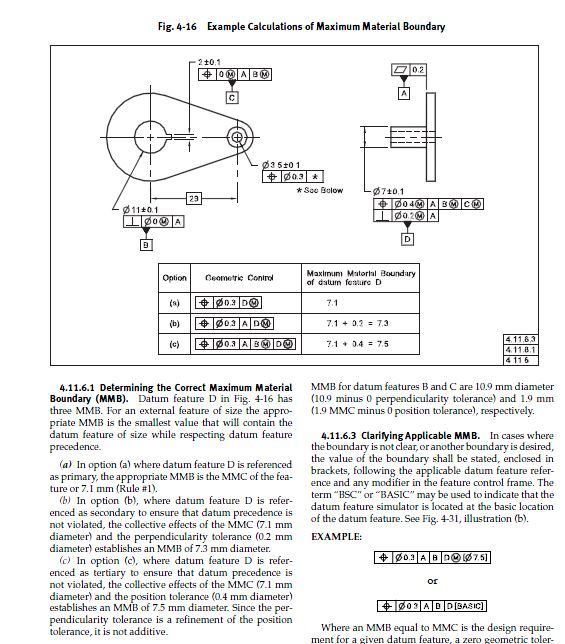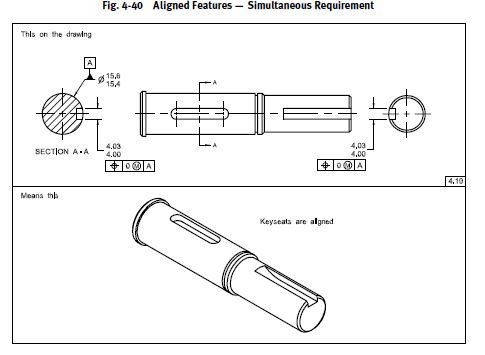Navigation
Install the app
How to install the app on iOS
Follow along with the video below to see how to install our site as a web app on your home screen.
Note: This feature may not be available in some browsers.
More options
Style variation
-
Congratulations MintJulep on being selected by the Eng-Tips community for having the most helpful posts in the forums last week. Way to Go!
You are using an out of date browser. It may not display this or other websites correctly.
You should upgrade or use an alternative browser.
You should upgrade or use an alternative browser.
fig 4-16 -Y14.5-2009 and datum feature C -as tertiary
- Thread starter gabimo
- Start date
- Status
- Not open for further replies.
Yes. The boss will not be located on the center-plane that passes through datum axis B and the datum center-plane established from/by the keyway - Datum C. Without Datum C the bosses can be located anywhere "around" datum axis B.
Certified Sr. GD&T Professional
Certified Sr. GD&T Professional
Datum C is not directly referenced at all in that section, so it doesn't appear to. It referenced Datum D, which is located using C as a tertiary, but I don't see how removing that would have any real impact on how to interpret the conditions explained in 4.11.6.1
Sorry. I missed the intent of you question. Removing C will NOT change the determination of MMB as discussed in 4.11.6.1 because C is not part of the calculation. It does, as I mention in my previous post, change the motion controlled for locating Datum feature D inself
Certified Sr. GD&T Professional
Certified Sr. GD&T Professional
And the drawing will still be fully defined (well only for the features shown anyway) due to the simultaneous requirement implied A primary and B(MMB ) secondary.
Therefore, C does nothing?
Can we conclude just that?
Or that is a stretch/ unfortunate misleading?
Therefore, C does nothing?
Can we conclude just that?
Or that is a stretch/ unfortunate misleading?
greenimi:
I agree with your statement for the simultaneous reqmnt. But I always waffle at not adding the "extra" datum (C). Although redundant, datum C adds clarity for those who are not cognizant with simultaneous reqmnt conventions.
Certified Sr. GD&T Professional
I agree with your statement for the simultaneous reqmnt. But I always waffle at not adding the "extra" datum (C). Although redundant, datum C adds clarity for those who are not cognizant with simultaneous reqmnt conventions.
Certified Sr. GD&T Professional
For my clarity, are we agreed that the material boundary at D does not change if there is no Datum C call out on the keyway and Datum C is not called out on the ∅7 post? But the part could now look like the attached image.
In reality you would only not have a datum C if there were no keyway, just a simple hole for Datum B, correct? But then the Datum D would become your clocking feature, that is needed, to use a profile geometric tolerance to describe the outer periphery of the part. Still correct?
In reality you would only not have a datum C if there were no keyway, just a simple hole for Datum B, correct? But then the Datum D would become your clocking feature, that is needed, to use a profile geometric tolerance to describe the outer periphery of the part. Still correct?
Does simultaneous requirements apply to sub-sets of the FCF? That would indicate that A|B and A|D would not allow repositioning relative to A. I'm not sure there is anything that supports something besides the entire Datum Reference Frame.
The language in the standard is vague on this. Perhaps:
When a Datum Reference Frame is referred to in multiple feature control frames, including datum feature modifiers, then the part shall not be repositioned when checking individual features that have tolerances based on that Datum Reference Frame.
The language in the standard is vague on this. Perhaps:
When a Datum Reference Frame is referred to in multiple feature control frames, including datum feature modifiers, then the part shall not be repositioned when checking individual features that have tolerances based on that Datum Reference Frame.
greenimi - Sure, when you write it that way. I do dislike this figure, as discussed previously.
I should have fallen back to an investigative method I suggested before, which is to envision the gauge required for each case and see if there would be any difference between them. This avoids trying to figure out which part variations are compliant in favor of looking at the compliance criteria. Since the simulator for C{M} is identical to the one that verifies the slot location, there is no difference, so I agree.
If [-D-] is changed to be controlled by [A|B(M)|C], in which case the gauges would not be the same for the removal of C.
I should have fallen back to an investigative method I suggested before, which is to envision the gauge required for each case and see if there would be any difference between them. This avoids trying to figure out which part variations are compliant in favor of looking at the compliance criteria. Since the simulator for C{M} is identical to the one that verifies the slot location, there is no difference, so I agree.
If [-D-] is changed to be controlled by [A|B(M)|C], in which case the gauges would not be the same for the removal of C.
- Status
- Not open for further replies.
Similar threads
- Replies
- 21
- Views
- 22K
- Replies
- 29
- Views
- 18K
- Question
- Replies
- 8
- Views
- 13K
- Locked
- Question
- Replies
- 1
- Views
- 2K
- Locked
- Question
- Replies
- 20
- Views
- 9K


